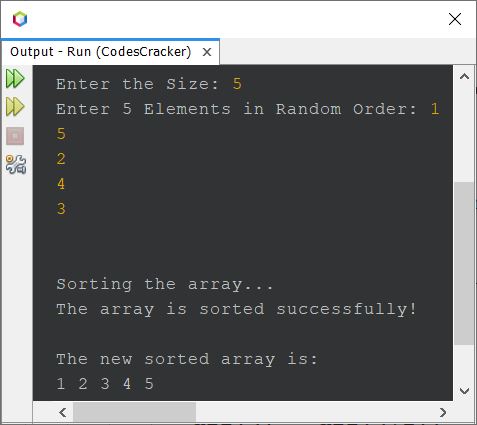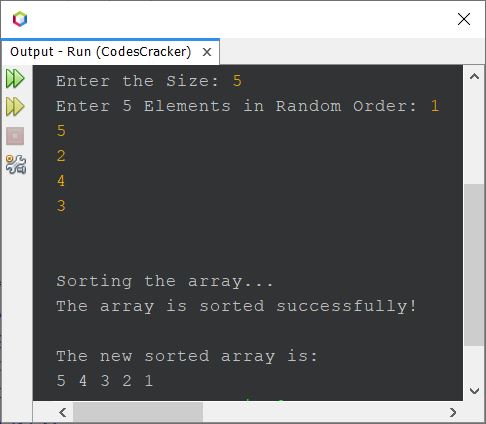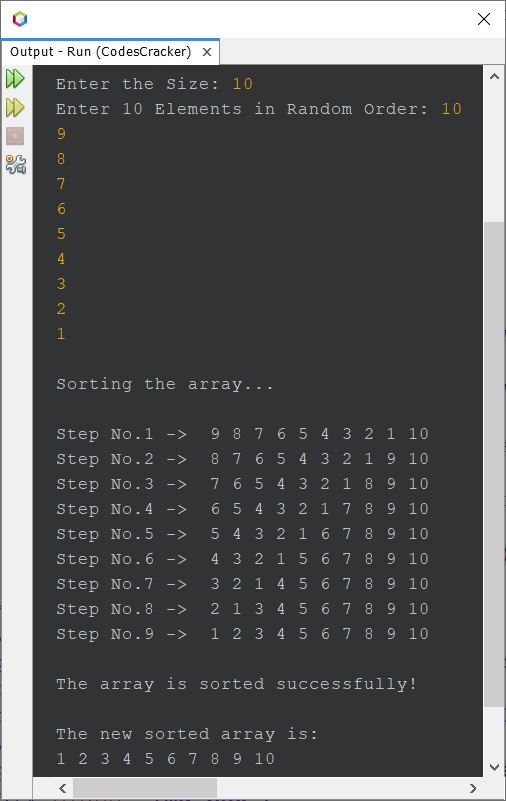- Java Basic Programs
- Java Programming Examples
- Java Print Hello World
- Java Get Input from User
- Java Print Integer
- Java Add two Numbers
- Java Check Even or Odd
- Java Check Prime or Not
- Java Check Alphabet or Not
- Java Check Vowel or Not
- Check Reverse equal Original
- Java Fahrenheit to Celsius
- Java Celsius to Fahrenheit
- Java Perfect Number Program
- Java Find Quotient Remainder
- Java Days to Seconds
- Java Count Digits in Number
- Java Binary Number Addition
- Java Discount Program
- Java Compute Courier Charge
- Java Find Telephone Bill
- Java Print ASCII Values
- Java Check Palindrome or Not
- Java Check Armstrong or Not
- Generate Armstrong Numbers
- Add two Numbers using Pointers
- Java Mathematical Programs
- Add Subtract Multiply & Divide
- Java Make Calculator
- Java Add Digits of Number
- Java Check Leap Year or Not
- Java Check Divisibility
- Java Find Simple Interest
- Java Find Compound Interest
- Java Print Fibonacci Series
- Java Find nCr nPr
- Calculate Average & Percentage
- Java Calculate Arithmetic Mean
- Java Calculate Student Grade
- Java Print Table of Number
- Java Print Prime Numbers
- Java Add n Numbers
- Java Interchange two Numbers
- Java Reverse Numbers
- Java Swap two Numbers
- Count Positive Negative & Zero
- Find Largest of two Numbers
- Find Largest of three Numbers
- Java Find Factorial of Number
- Java Find HCF & LCM
- Area & Perimeter of Square
- Area & Perimeter of Rectangle
- Area & Circumference of Circle
- Java Conversion Programs
- Java Decimal to Binary
- Java Decimal to Octal
- Java Decimal to Hexadecimal
- Java Binary to Decimal
- Java Binary to Octal
- Java Binary to Hexadecimal
- Java Octal to Decimal
- Java Octal to Binary
- Java Octal to Hexadecimal
- Java Hexadecimal to Decimal
- Java Hexadecimal to Binary
- Java Hexadecimal to Octal
- Java Pattern Programs
- Java Pattern of Stars
- Java Pattern of Alphabets
- Java Pattern of Numbers
- Java Pyramid of Stars
- Java Pyramid of Alphabets
- Java Pyramid of Numbers
- Java Print Diamond Pattern
- Java Print Floyd Triangle
- Java Print Pascal Triangle
- Java Array Programs
- One Dimensional Array Program
- Java Linear Search
- Java Binary Search
- Find Largest Element in Array
- Find Smallest Element in Array
- Java Reverse Array
- Insert Element in Array
- Delete Element from Array
- Java Merge two Array
- Java Bubble Sort
- Java Selection Sort
- Java Insertion Sort
- Java Find Common Elements
- Java Count Even/Odd Number
- Two Dimensional Array Program
- Java Add two Matrices
- Java Subtract two Matrices
- Java Transpose Matrix
- Multiply two Matrices
- Three Dimension Array Program
- Java String Programs
- Java Print String
- Find Length of String
- Java Compare two String
- Java Copy String
- Java Concatenate String
- Java Reverse String
- Delete Vowels from String
- Delete Words from Sentence
- Find Occurrence of a Character
- Java Find Occurrence of a Word
- Occurrence of Each Character
- Java Occurrence of Each Word
- Java Count Repeated Characters
- Java Count Repeated Words
- Java Capitalize Each Word
- Java Count Vowels/Consonants
- Java Extract Numbers
- Java Count Word in String
- Remove Spaces from String
- Java Sort a String
- Java Uppercase to Lowercase
- Java Lowercase to Uppercase
- Java Swap two Strings
- Java Check Anagram or Not
- Java Check Balance Parentheses
- Java Check Password Strength
- Java File Programs
- Java Read File
- Java Write to File
- Read & Display File Content
- Java Copy File
- Java Append Text to File
- Java Merge two File
- List files in Directory
- Java Delete File
- Java Miscellaneous Programs
- Generate Random Numbers
- Java Print Time & Date
- Java Get IP Address
- Java Shutdown Computer
- Java Programming Tutorial
- Java Tutorial
Java Program - Bubble Sort
This article is created to cover a program in Java that performs the sorting of an array using bubble sort technique. That is, this article includes multiple bubble sort programs in Java. List of bubble sort programs included in this article:
- Bubble sort program in Java - basic version
- Bubble sort program in Java - complete version
- Bubble sort program in Java - descending order
- Bubble sort with printing of new array after each sort
If you're not aware about, How bubble sort works ?
Refer to Bubble Sort Logic.
Now let's move on, and create a bubble sort program in Java.
Bubble Sort in Java - Basic Version
The question is, write a Java program to perform bubble sort based on 10 elements. The 10 elements must be received by user at run-time of the program. The program given below is its answer. This program sorts in ascending order.
import java.util.Scanner; public class fresherearth { public static void main(String[] args) { int n=10, i, j, x; int[] array = new int[n]; Scanner s = new Scanner(System.in); System.out.print("Enter 10 Elements in Random Order: "); for(i=0; i<n; i++) { array[i] = s.nextInt(); } for(i=0; i<(n-1); i++) { for(j=0; j<(n-i-1); j++) { if(array[j]>array[j+1]) { x = array[j]; array[j] = array[j+1]; array[j+1] = x; } } } System.out.println("\nThe new sorted array is:"); for(i=0; i<n; i++) System.out.print(array[i]+ " "); } }
The snapshot given below shows the sample run of above bubble sort program in Java, with user input 10, 19, 11, 18, 12, 17, 13, 16, 14, 15 as ten elements in random order. Random order means, all the elements are neither in ascending nor in descending order:

Bubble Sort in Java - Complete Version
Since previous program operates based on 10 elements or numbers only. Therefore I've modified that program to allow user to define the size of array too, along with its elements.
import java.util.Scanner; public class fresherearth { public static void main(String[] args) { Scanner s = new Scanner(System.in); System.out.print("Enter the Size: "); int n = s.nextInt(); int[] arr = new int[n]; System.out.print("Enter " +n+" Elements in Random Order: "); for(int i=0; i<n; i++) arr[i] = s.nextInt(); System.out.println("\n\nSorting the array..."); for(int i=0; i<(n-1); i++) { for(int j=0; j<(n-i-1); j++) { if(arr[j]>arr[j+1]) { int temp = arr[j]; arr[j] = arr[j+1]; arr[j+1] = temp; } } } System.out.println("The array is sorted successfully!"); System.out.println("\nThe new sorted array is:"); for(int i=0; i<n; i++) System.out.print(arr[i]+ " "); } }
The sample run with user input 5 as size, 1, 5, 2, 4, 3 as five elements, is shown in the snapshot given below:

Bubble Sort in Java - Descending Order
To sort an array in descending order, using bubble sort technique, only replace that greater than (>) sign to less than (<), that is available inside condition of if statement, in the sorting loop. That is, replace:
if(arr[j]>arr[j+1])
from above program, with:
if(arr[j]<arr[j+1])
Only the matter of a sign, a single character. The whole program gets changed. Here is the snapshot of sample run with same user input as of previous program's sample run:

Bubble Sort in Java - Print Array after Each Sort
This is the last program of this article, created to print new array after each sort using bubble sort technique. This program provides the rough look, how the bubble sort actually performs.
import java.util.Scanner; public class fresherearth { public static void main(String[] args) { Scanner s = new Scanner(System.in); System.out.print("Enter the Size: "); int n = s.nextInt(); int[] arr = new int[n]; System.out.print("Enter " +n+" Elements in Random Order: "); for(int i=0; i<n; i++) arr[i] = s.nextInt(); System.out.println("\nSorting the array..."); for(int i=0; i<(n-1); i++) { for(int j=0; j<(n-i-1); j++) { if(arr[j]>arr[j+1]) { int temp = arr[j]; arr[j] = arr[j+1]; arr[j+1] = temp; } } System.out.print("\nStep No." +(i+1)+ " -> "); for(int j=0; j<n; j++) System.out.print(arr[j]+ " "); } System.out.println("\n\nThe array is sorted successfully!"); System.out.println("\nThe new sorted array is:"); for(int i=0; i<n; i++) System.out.print(arr[i]+ " "); } }
Here is its sample run with user input 10 as size, 1, 10, 2, 9, 3, 8, 4, 7, 6, 5 as ten elements:

Below is another sample run with same user input as size, and 10, 9, 8, 7, 6, 5, 4, 3, 2, 1 as ten elements:

Same Program in Other Languages
« Previous Program Next Program »